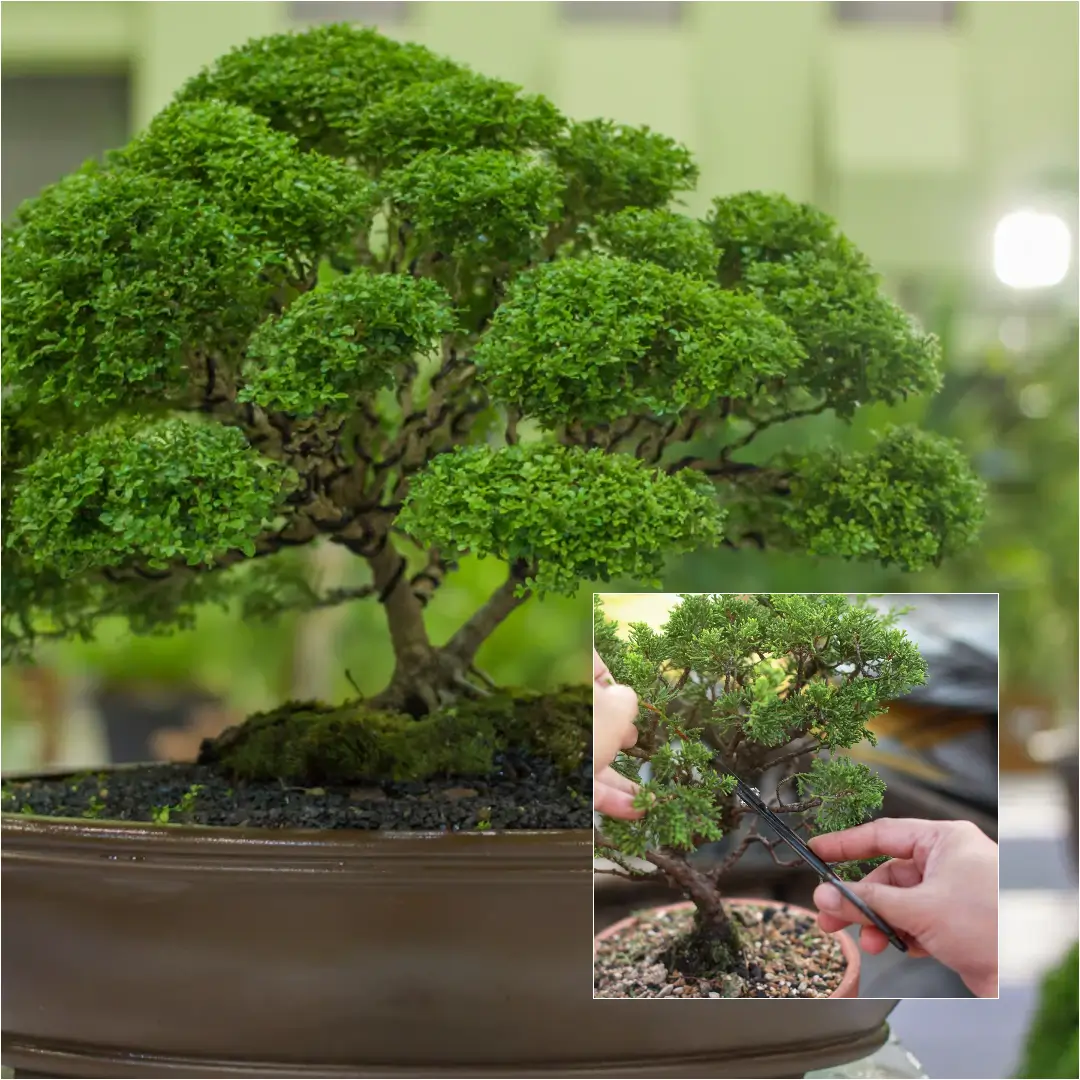Caring for a Bonsai tree can seem like a complex task, but once you understand the fundamentals, it’s both rewarding and enjoyable. Bonsai trees are unique not only in their miniature size but in the way they require special attention due to being grown in small pots. From placement and watering to repotting and pest control, learning how to care for a bonsai tree requires understanding the intricacies of this delicate art. In this guide, we’ll walk you through everything you need to know about caring for a bonsai tree.
Bonsai Tree Care Basics
The Unique Nature of Bonsai Trees
Bonsai trees are more than just small plants; they are living art. Because they are grown in shallow containers, they require a very specific kind of care for a bonsai tree. The limited soil and space for roots mean that basic practices like watering, fertilizing, and repotting need to be done with greater attention than with regular houseplants. Bonsai trees may be delicate, but don’t let that intimidate you! If you follow some simple care for a bonsai tree guidelines, you’ll be able to nurture a beautiful, thriving bonsai tree.
Why Proper Care Matters
Taking proper care of a bonsai tree isn’t just about keeping it alive; it’s about promoting its long-term health and shaping it over time. You get to decide how it looks, how it grows, and what shape it takes. Think of it as a miniature world that you’re in charge of. This is where care for a bonsai tree becomes an exciting journey, blending creativity with nature.
Placement of Your Bonsai Tree
Indoor vs. Outdoor Bonsai
One of the first things you need to figure out when learning how to care for a bonsai tree is where to place it. This depends largely on the species of your bonsai. Some bonsai trees are meant to thrive outdoors, where they can get plenty of sunlight and experience natural temperature changes. Outdoor bonsai types include species like Juniper, Pine, and Maple.
Indoor bonsai trees, on the other hand, such as Ficus or Jade, prefer a more controlled environment. They need indirect light and a more consistent temperature. So before you decide where to place your bonsai, make sure you know if it’s meant for indoors or outdoors.
Choosing the Right Spot
The right placement is key to good bonsai health. Outdoor bonsai generally need to be placed where they can get morning sun and some shade in the afternoon, especially during hotter months. Indoor bonsai should be placed near a window where they can get plenty of indirect sunlight.
If you live in a particularly sunny area, be cautious about exposing your bonsai to direct sunlight for too long, as it can scorch the leaves. Similarly, cold drafts can be harmful to bonsai trees, so make sure they’re away from doors or windows where they might catch a chill.
Watering Your Bonsai Tree
How Often Should You Water?
Watering is probably the most important part of bonsai care, and it’s where a lot of people go wrong. How often should you water your bonsai? Well, that depends. Factors like the species of your tree, the size of its pot, the soil mixture, the time of year, and even the climate you live in can all affect how much water your bonsai needs.
The key is to check the soil regularly. Stick your finger about an inch into the soil—if it feels dry, it’s time to water. If it’s still damp, wait a day and check again. One thing you don’t want to do is overwater, as that can lead to root rot. A good rule of thumb is to water thoroughly when you do water, making sure the entire root system is saturated, but letting the soil dry out slightly between waterings.
Best Practices for Watering
When you water your bonsai, make sure to pour water evenly over the soil surface. Water should run out of the drainage holes at the bottom of the pot, which ensures that the roots are getting enough hydration. If the soil is compacted and water pools on the surface, you may need to loosen the soil a bit.
Another tip is to avoid using hard water, which can leave mineral deposits in the soil. If possible, use rainwater or filtered water to keep your bonsai tree happy.
Fertilizing Your Bonsai Tree
Why Fertilizer Is Important
Since bonsai trees grow in such small pots, they can’t extend their roots in search of nutrients like trees in the wild. That’s why regular fertilizing is essential. Fertilizer provides the nutrients your bonsai needs to grow strong and healthy.
When and How to Fertilize
During the growing season (typically spring through fall), it’s important to fertilize your bonsai regularly. Use a balanced fertilizer that contains nitrogen, phosphorus, and potassium. Follow the instructions on the package, but generally, it’s a good idea to feed your bonsai once every two weeks.
In the winter months, you can reduce the frequency of fertilizing or stop altogether, as most bonsai trees go into a dormant phase.
Repotting Your Bonsai Tree
Why Repotting Is Necessary
Bonsai trees are constantly growing, and because they’re confined to small pots, the roots eventually take up all the available space. If left unchecked, this can lead to the tree becoming “pot-bound,” where the roots grow in circles, choking the tree and preventing it from absorbing nutrients. To properly care for a bonsai tree, it’s important to repot your bonsai every couple of years, depending on its growth rate. Regular repotting is essential to ensure the health and vitality of your tree as you continue to care for a bonsai tree.
How to Repot a Bonsai
Repotting may sound intimidating, but it’s actually a straightforward process. Start by carefully removing the tree from its pot. Gently comb out the roots to remove old soil, and trim back any roots that have become too long or tangled.
Place the tree in fresh bonsai soil—this is crucial because bonsai soil provides the right balance of drainage, aeration, and nutrient retention. After placing the tree back in the pot, water it thoroughly to help it settle into its new environment.
Choosing the Right Soil (Substrate)
What Kind of Soil Does a Bonsai Tree Need?
The soil you use for your bonsai tree is one of the most important factors in its overall health. Bonsai soil needs to drain well while still holding enough moisture to sustain the tree between waterings. It also needs to provide enough aeration for the roots to breathe.
The soil you use for your bonsai tree is one of the most important factors in its overall health and in how you care for a bonsai tree. Bonsai soil needs to drain well while still holding enough moisture to sustain the tree between waterings. It also needs to provide enough aeration for the roots to breathe. Selecting the right soil is essential to ensure the proper care for a bonsai tree, as it directly impacts its growth and vitality.
Dealing with Pests and Diseases
Common Pests That Attack Bonsai Trees
Just like any other plant, bonsai trees can fall victim to pests and diseases. Some common pests to look out for include aphids, spider mites, and scale. If you notice any signs of infestation—such as yellowing leaves, tiny webs, or strange growths—it’s important to act quickly.
You can remove pests by washing the tree with a gentle insecticidal soap or spraying it with a neem oil solution. Make sure to check your bonsai regularly, as pests can spread quickly if left unchecked.
How to Prevent Disease
Healthy trees are less likely to get sick, so the best defense against disease is proper care for a bonsai tree. Keep an eye out for signs of root rot (which happens when the tree is overwatered), leaf spots, or mold. If you notice any issues, make adjustments to your watering, light exposure, or humidity levels.
Overwintering Your Bonsai Tree
Winter Care Based on Tree Species
How you care for a bonsai tree in the winter will depend on the species of your tree and where you live. Outdoor bonsai trees, like junipers and maples, need a period of dormancy during the winter, where they rest and prepare for the next growing season.
If you live in a cold climate, it’s important to protect your bonsai from freezing temperatures. To properly care for a bonsai tree in these conditions, you can bring the tree into a garage or shed, or insulate the pot with mulch or straw. Just make sure the tree still gets some light and water during this time, as proper winter care is essential for its health.
For indoor bonsai trees, the main challenge in winter is providing enough light, as the days are shorter. You may want to supplement natural light with a grow light to ensure your bonsai continues to thrive.
Caring for a bonsai tree is a rewarding experience that requires attention to detail and a bit of patience. Whether it’s finding the perfect spot, mastering the art of watering, or learning when to repot, every aspect of care for a bonsai tree contributes to its health and beauty. Think of your bonsai as a living masterpiece—one that reflects your dedication, creativity, and nurturing touch.
Taking care of a bonsai tree may seem daunting at first, but once you grasp the basics, it becomes a relaxing and fulfilling hobby. Whether you’re growing your bonsai indoors or out, following these guidelines will help ensure your tree flourishes for years to come. Happy growing!
FAQs
How do you take care of a bonsai tree for beginners?
Taking care for a bonsai tree as a beginner involves mastering the basics: placement, watering, and pruning. Start by placing your bonsai in the right location based on whether it’s an indoor or outdoor variety. Water it when the top inch of soil feels dry, and prune regularly to shape the tree and encourage healthy growth. To properly care for a bonsai tree, fertilize during the growing season and repot the tree every couple of years to keep the roots healthy and thriving.
How often do you water a bonsai tree?
The frequency of watering when you care for a bonsai tree depends on factors like the species of the tree, the size of the pot, the soil mixture, and the climate. Typically, you should water your bonsai when the top inch of soil feels dry to the touch. Water deeply until you see water draining from the bottom of the pot. In summer, you may need to water more often, while in winter, watering can be less frequent. Proper watering is a crucial aspect of how you care for a bonsai tree throughout the year.
How do you keep an indoor bonsai tree alive?
To care for a bonsai tree indoors and keep it alive, ensure it gets plenty of indirect sunlight by placing it near a bright window. Water it when the soil begins to dry out and avoid overwatering to prevent root rot. Regularly prune your tree to maintain its shape, and use a balanced fertilizer during the growing season. A key aspect of care for a bonsai tree is monitoring the environment for humidity, as bonsai trees thrive in slightly humid conditions. If needed, use a humidity tray or mist the leaves occasionally to help maintain moisture.
How do I keep my bonsai tree happy?
To care for a bonsai tree and keep it happy, ensure it has the right balance of sunlight, water, and nutrients. Keep a close eye on its soil moisture, and avoid both overwatering and underwatering. Fertilize regularly during the growing season, prune to maintain its shape, and repot every couple of years to promote healthy root growth. Proper care for a bonsai tree also means keeping it free from pests and diseases, which is key to its long-term happiness.


